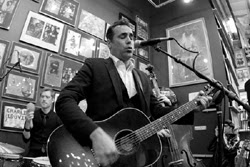Yes can almost be split into two disparate, but
equally satisfying halves. On one hand are the straight ahead pop songs of the
type that can be heard on Cure for Pain. Tracks like
"Scratch," "Whisper" and "All Your Way" would not
be out of place on that record. The other half of Yes introduces
experiments with dissonance, spoken word, and the use of space to create
tension.
Some of the
experimentation on Yes is subtle and sprinkled in to create unexpected
detours. An example is in "Radar," where Sandman plays with spoken
word and the use of empty space to step out of the time signature. He seems to
relish in this new found freedom by drawing out his unaccompanied "I've
got all the time in the world…I've got all the time in the world…to spare"
before the band hops back on and rides the groove home.
But for all of the subtlety, there are a handful of out
and out curve balls like "The Jury" and "Sharks." On these
songs, you can hear Sandman's adoration for the Beat poets not only in his
delivery but also in his imagery. On "The Jury" Sandman plays a judge
who struggles in the sentencing of a beautiful woman by wavering between
whispered, serene images of "candlelight, red wine, Caesar salad" and
the commanding, sterile language of a courtroom. Behind him, Dana Colley
creates the perfect musical counterpart evoking the image of an irresistible
woman while Sandman doles out intermittent bass stabs to indicate a sinister
intent.
The experimentation isn't relegated to the vocals as the
band can be heard pushing personal boundaries as well as those of the group.
Examples can be heard in the pummeling sax solo on "Free Love" and
the reckless abandon displayed by the band in the choruses of
"Sharks" and "Super Sex."
The songs on Yes are darker and less predictable
than those on Cure For Pain, and sexier as a result. This can be
attributed to the late great Mark Sandman, whose restlessness consistently paid
off. Truly, there will never be another band quite like Morphine, and Yes
will remain a compelling document to behold for years to come.
-
Paul Custer
































